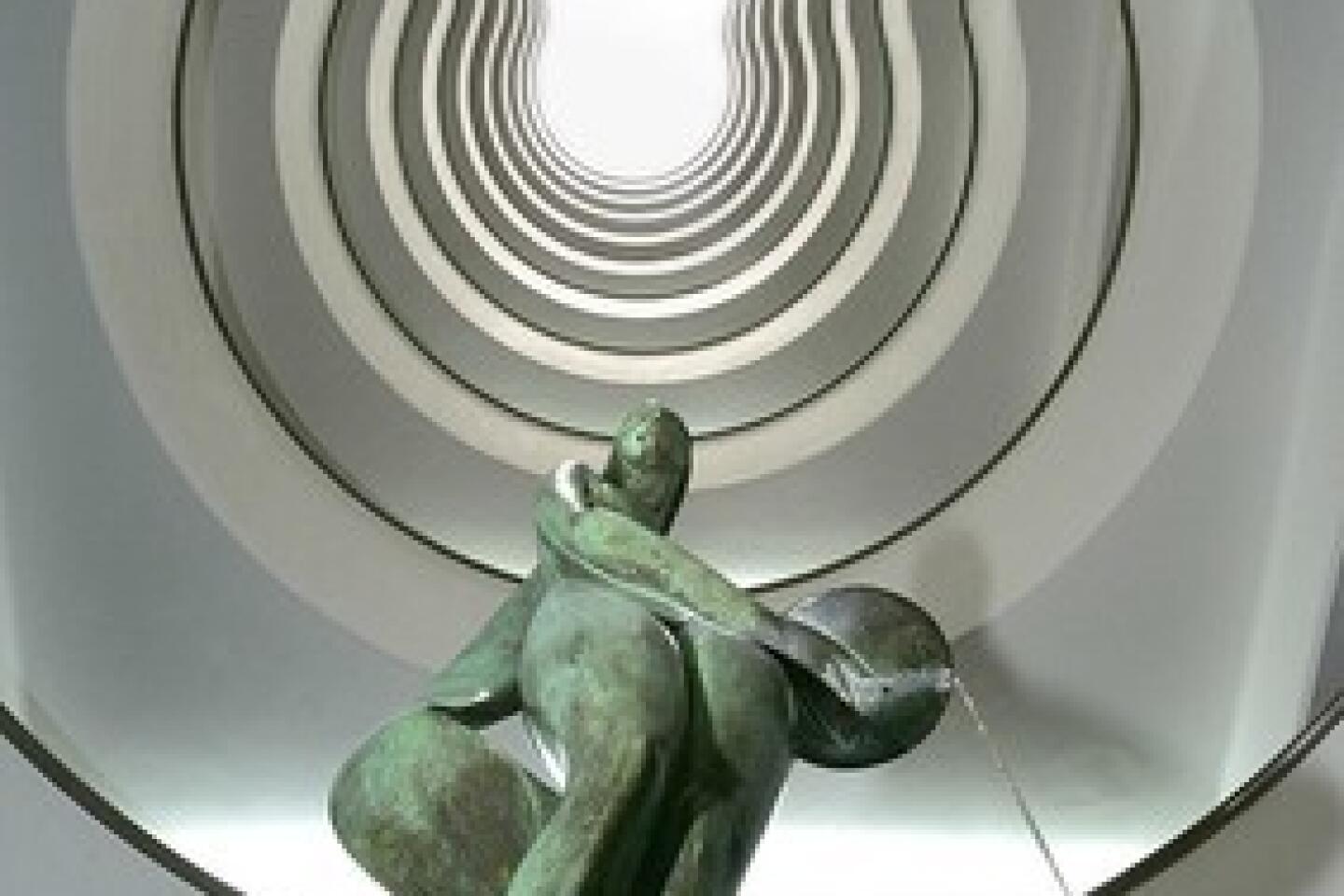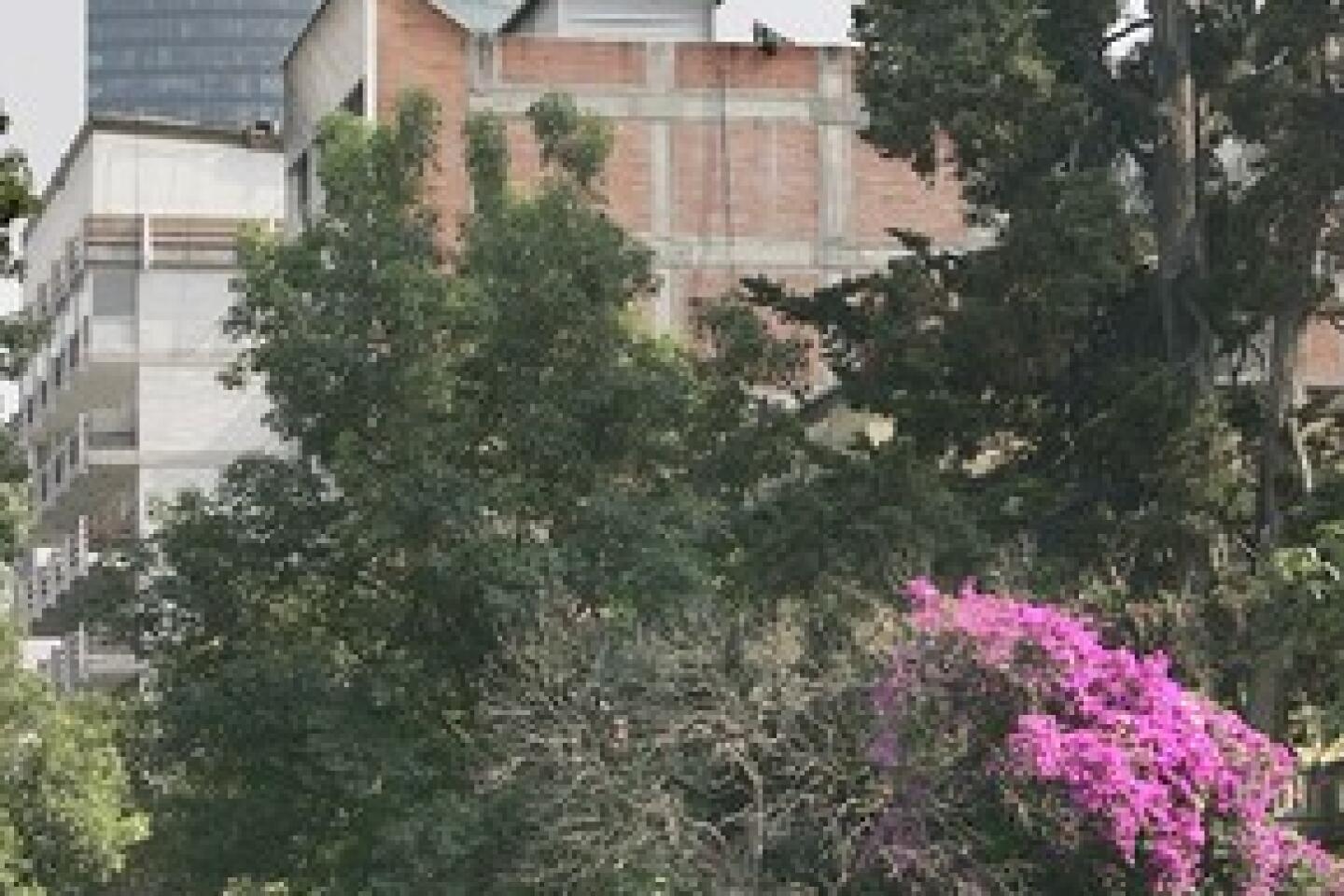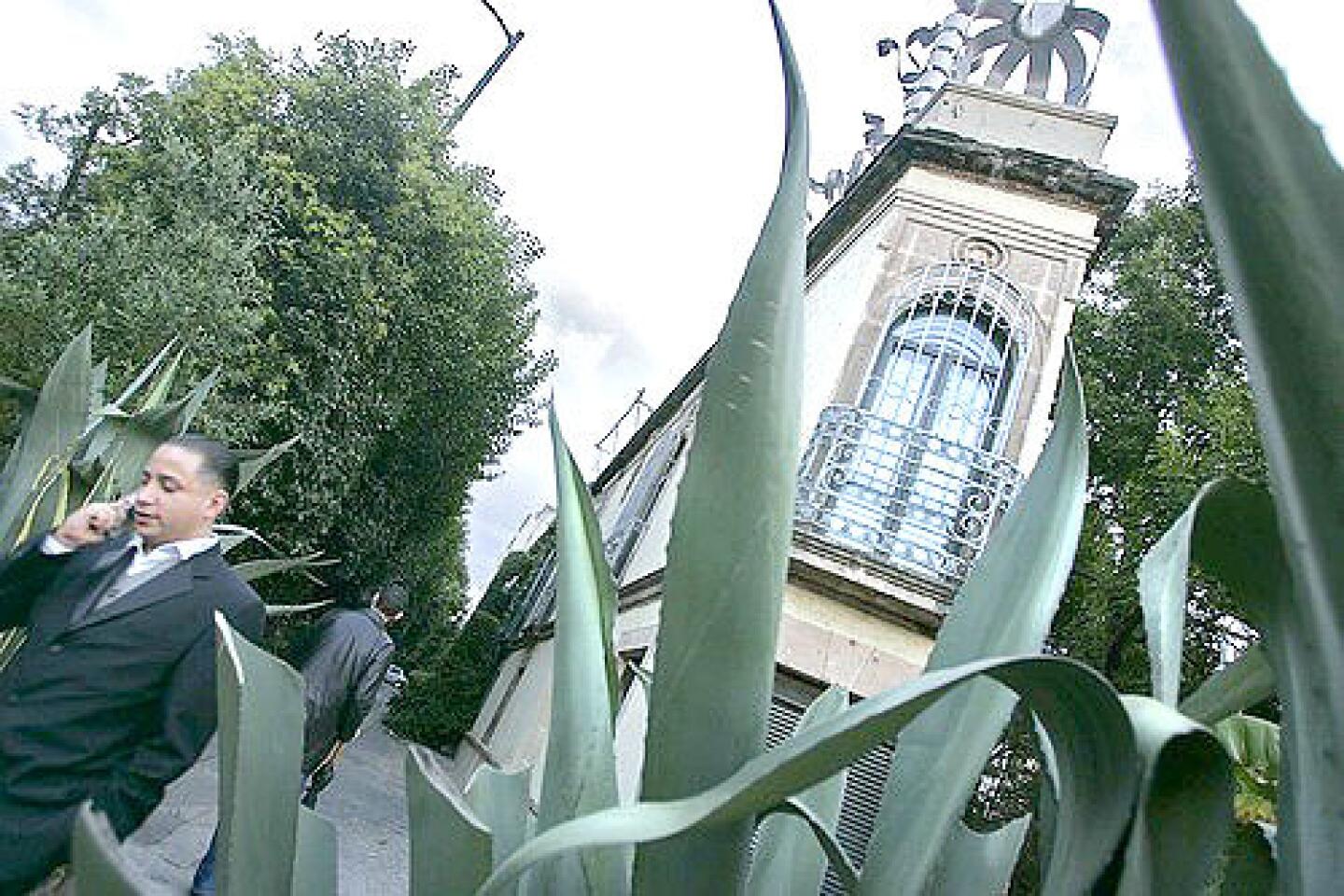Ecléctico in the city
IN Tony Scott’s action thriller “Man On Fire,” there’s a scene where a bodyguard played by Denzel Washington realizes that his young client (Dakota Fanning) is about to be kidnapped. Time slows to a crawl, the camera does a loopy 360-degree pan, and the audience sees the world through the bodyguard’s eyes — edgy, alluring and wildly unpredictable.
The neighborhood where this memorable sequence occurs is Condesa, a leafy, Art Deco-studded oasis in the heart of this stressed-out metropolis of about 22 million. Over the last several years, Condesa (pronounced con-DAY-sah) has acquired a reputation as one of this unruly city’s most compelling, and occasionally jarring, places to live. It boasts some of the region’s trendiest bars and restaurants, splashiest avant-garde architecture and, arguably, its most intriguing mix of residents and residential options — from classic 1930s Deco private homes to chic new loft apartments.
Condesa also offers plenty of evidence as to why Los Angeles and the Mexican capital are sister cities. Occupying a roughly pentagon-shaped area southwest of the city’s historic center, Condesa is Mexico City’s Silver Lake and Los Feliz rolled into one, with traces of West Hollywood, Boyle Heights and several other Spanish-speaking urban barrios. “It has an air of Buenos Aires or Barcelona,” says Federico Campbell, a novelist and essayist who has lived in the community since 1997.
Like L.A., Condesa has long been a source of fascination for the film business and the image-manufacturing industry. Movie directors, novelists, soap opera writers, musicians, painters, architects and academics, among others, all make their homes here alongside the quaint flower stalls, mom-and-pop taco stands and curbside shrines to the Virgin of Guadalupe that give the district a touch of old-fashioned charm.
Condesa also is one of the city’s most photogenic and visually iconoclastic locales. The neighborhood attained its first architectural golden age in the 1920s, ‘30s and ‘40s, when the Mexican screen diva María Félix was shooting movies in the 12-story, Bauhaus-influenced Edificio Basurto and the buildings were as glamorous as the human stars. And like L.A., Condesa appears to have woken up just in time to start restoring and preserving its crumbling Art Deco gems for future generations.
Small wonder the neighborhood has kept its cachet with film location scouts. Besides “Man On Fire” (2004), numerous commercials, telenovelas and a section of Alejandro González Iñárritu’s “Amores Perros” (2000) have been filmed here in recent years.
These contemporary portraits have given much-maligned Mexico City a global identity as a complex, multi-strata urban-scape where ancient and modern, elegance and squalor, coexist. Condesa too is a neighborhood that has spent decades getting ready for its close-up. Shattered by the monster earthquake that struck Mexico City 21 years ago, the area for a time was all but abandoned, its once-fashionable buildings dirty and decaying, its parks and plazas dimly lighted and dangerous.
TODAY, Condesa is easily the city’s most de moda district. Classic Deco apartment houses that once were rotting are being rehabilitated. Sleek new residential glass-and-steel towers, some equipped with shared interior courtyards, rooftop swimming pools, hanging gardens and other high-end accessories, are sprouting like summer lilies. Both locals and tourists, with New York, French or lisping Madrid accents, loll in sidewalk cafes and chat away evenings in smoky tapas bars. The abundant parks offer a respite for rendezvousing lovers and parents with rambunctious children.
But Condesa isn’t some gated enclave, removed from the city’s bustle and grit. The neighborhood and those adjoining it, though gentrifying, still contain a social and economic cross-section of the capital.
“For me, the most important thing about Condesa is the lifestyle. It’s more urban, it’s more diverse,” says Victor Sánchez, 42, a Stanford-educated software specialist who recently bought an apartment in Condesa with his wife, Cecilia López, 33, a college architecture instructor.
Though the couple had to spend “about a year” searching for a home in the tight housing market, they say it was worth the wait. Besides its other attractions, they were drawn to the neighborhood’s relatively central location in a sprawling mega-city where enduring a long rush-hour commute can take years off your life. While a number of their friends have moved to more sanitized, suburbanized locations, the childless couple prefer Condesa’s eclectic vibe. “Many of our friends who don’t live here want to live here,” says López.
Of course, there’s a downside to its surging popularity. Some poorer residents have been driven out by rising rents. Weekday parking is a nightmare. In recent months, construction cranes seemed to cast a shadow over practically every block.
Like Washington’s on-screen character, longtime denizens might have the sensation that the neighborhood is spinning around them. Some wonder if Condesa is being victimized by its own success.
But it’s hard to find anyone who plans on leaving. “I wouldn’t know where else to live,” says architect Derek Dellekamp, 35, who shares an apartment with his wife, photographer Lara Becerra, in the striking, stacked-aluminum apartment building he designed. “I started doing it for a client and I ended up marrying her,” Dellekamp explains with a laugh.
His building, which is constructed around a shared interior courtyard and a communal garden, was one of several in the neighborhood included in last year’s exhibition, “Mexico City Dialogues: New Architectural Practices” at the Center for Architecture in New York.
The same exhibition featured the work of Higuera + Sánchez, another ambitious young Mexico City firm that was one of the first to build loft-style apartments here. It has been putting its stamp on Condesa’s new experimental architecture with a number of airy, angular, steel, concrete and glass apartment buildings (full disclosure: this writer lives in one), as well as the chic, opaque-glass qi gym, where guitarist José Alfredo Rangel Arroyo, a.k.a. Joselo, of the popular Mexican alt-rock band Café Tacuba often can be spotted sweating away on the treadmill.
Yet another young architect, Alberto Kalach, who designed the just-opened Biblioteca Vasconcelos national library in downtown Mexico City, is represented in Condesa by an apartment building that playfully balances a heavy concrete superstructure with a futuristic, see-through glass interior that makes the building’s units seem to float above the surrounding streets.
Alas, an increasing number of modern Condesa apartments are drab, hulking copycats of earlier, better buildings. In Mexico City, lax building codes and even more lax code enforcement have created a wide-open architectural environment where, for better and worse, experimentation is encouraged and relatively young twenty- and thirtysomething designers can get work. Condesa has been one of the trend’s chief beneficiaries, as well as its sometime dupe.
“Mexico City is like a laboratory,” says Dellekamp. “It’s because it’s growing so fast. It’s because the social differences are so extreme and it has a great history.”
In Condesa’s case, that history dates to the beginnings of the last century, when the city government launched the new residential district in 1902. Named for an old house on the premises owned by a colonial-era Spanish countess (“condesa” is Spanish for countess), the neighborhood incorporates two oval-shaped streets, the inner Avenida México and the outer Avenida Amsterdam, that are the remains of a former horse racing track (“hipódromo” in Spanish).
A few years after development began, the Mexican Revolution broke out and further construction halted until peace returned in the 1920s. Over the next 20 to 30 years, the neighborhood became a haven for immigrants (particularly Jews), foreign expats and bohemians, as well as a magnet for modern architectural styles that expressed the dynamic post-revolutionary nation.
Technically, the area consists of three neighborhoods: Condesa, Hipódromo and Hipódromo-Condesa. Two older, artier, less-gentrified neighborhoods to the east, Roma Norte and Roma Sur, though separated from Condesa by the roaring traffic and neon glare of Avenida Insurgentes, are culturally and commercially linked to Condesa. Residents and weekend day-trippers in search of diversion constantly wander back and forth among the five neighborhoods.
“There are people who never leave Condesa,” says Mario Torres Peña, 50, a painter who lives in Roma but regularly crosses over Insurgentes Avenue. “There’s everything. There are restaurants, there are bars, there are places to dance.”
LIKE many urban renaissances, Condesa’s revival grew out of disaster. On the morning of Sept. 19, 1985, a temblor measuring 8.1 on the Richter scale devastated the capital, killing at least 10,000 people, leaving thousands more homeless and destroying hundreds of structures.
Condesa and the Roma district were among the hardest-hit areas because they were built over part of the ancient lakebed that once surrounded the Aztec capital of Tenochtitlan (present-day Mexico City). When the Spanish conquistadors occupied the city, they began filling in the lake, but the soft subsoil that remains tends to magnify the deadly shaking effects of the area’s frequent tremors.
In the quake’s aftermath, Condesa has become a pioneer in showcasing experimental new forms of residential dwellings. But it also has fought to preserve its rich architectural past. Mexico City reputedly has the hemisphere’s highest concentration of Art Deco anywhere south of Miami, and over the last half-dozen or so years Condesa has become ground zero of the capital’s Deco revival. Dozens of Deco apartment buildings and private homes dot the neighborhood, many now upgraded or fully restored, a few still deserted and teetering on the brink of extinction — but unlikely to stay that way for long.
Patricia Arriaga Jordán, 53, a well-known film and television writer, director and producer, says that as a child she used to visit her grandmother’s home on Amsterdam Avenue. But many members of her own middle-class generation gave up on the old inner-city neighborhood and fled to developing, Americanized suburbs such as Satélite and Santa Fe. “I think it was a mistake,” she says. Mexico City “should have been like Barcelona,” she believes, where city officials carefully limited new residential construction, encouraging the middle class to remain in the city.
A year ago, Arriaga Jordán and her husband John Page, 76, a professor of Chinese literature at the Colegio de México, decided that with their children grown it was time to sell their family home in the southern San Ángel district. They moved into the 2,475 square-foot penthouse of a meticulously restored Art Deco apartment house built in 1931 on a tranquil Condesa plaza.
Known as the Edificio Lux, the building was constructed by prominent architect Ernesto Buenrostro, who also designed the nearby Edificio San Martín on the Parque México. Because of the structure’s architectural merit, its renovation was supervised by the National Institute of Fine Arts. Fortunately, Arriaga Jordán says, the building had not undergone much alteration of its original floor plan or ornamentation over the years.
A granite-covered staircase leads to the couple’s penthouse unit, with an enclosed terrace that faces a tree-encircled public fountain on the streets below. Their living room, just off the terrace, artfully contrasts modular modern furniture with Indian sculptures dating stylistically from pre-Columbian times, and a ponderous bookshelf that bisects the room horizontally. Page’s study overlooks the terrace, while Arriaga Jordán rents an office just down the street.
Though Page was skeptical of the move at first, the empty-nester couple now appreciate living in a neighborhood with four bookstores, dozens of restaurants, plenty of shared public space and an enveloping sense of community. “The one thing I really like is the mix of people,” Arriaga Jordán says. By contrast, she says, in San Ángel, a colonial-era district where the rich live barricaded behind high stone walls, “it’s all upper-middle class. We all look the same, we dress the same.”
The area’s Deco pièce de résistance is the Edificio Basurto, which rises across Sonora Avenue near the northeast end of Parque Mexico. Built between 1941 and 1944, it’s the masterwork of celebrated architect Francisco Serrano. This soaring, geometric edifice, with its garden balconies and spiraling interior reminiscent of Frank Lloyd Wright’s Guggenheim Museum, incarnates the futurismo optimism of Condesa’s mid-century developers.
Hit hard by the ’85 quake, the 42-unit building (including two penthouses) has been substantially reinforced and converted to condominiums. It also enjoys protection by the nation’s cultural commission, which must approve all changes or renovations, right down to the color of the exterior paint. “It’s the most precious, beautiful building,” says Adriana Talazuelos, the property’s manager. “It’s a jewel.”
Among the notable names attached in the past to the Basurto are Paul Westheim, a German-Jewish art critic who came to Mexico fleeing the Nazis and became an influential authority on Mexican art; and the Chilean writer-director Tito Davison, who filmed several movies in the building, including “La Diosa Arrodillada” (“The Kneeling Goddess”), a 1947 mystery-melodrama starring screen star Félix.
Other former Condesa and Roma residents linked to famous neighborhood sites include Tina Modotti, the Italian-born actress, ardent communist, photographer and lover-muse of fellow camera bug Edward Weston (she’s the subject of one of his most sensual nudes). For a time after moving to Mexico City, Modotti lived in a triangle-shaped building on Veracruz Street, which today bears her name. And Beat writer William S. Burroughs fatally shot his wife Joan while aiming at a cocktail glass on her head while living in Roma. (Their old home has since been torn down.)
Gilding Condesa’s cultural lily, last spring President Vicente Fox helped christen the new Centro Cultural Bella Época, a cultural center built around an Art Deco cinema designed by U.S. architect S. Charles Lee. The 32,000 square-foot center, whose restoration and expansion was done by Mexican architect Teodoro González de León, includes an art-house movie theater, an art gallery, a cafe and what is billed as Latin America’s largest bookstore.
As Condesa’s boom continues, no doubt the whispers will keep getting louder that the area has peaked and is on the downslide. Too trendy. Too expensive. Too many valets cramming more and more SUV’s onto the already crowded weekend sidewalks.
“There are extremely interesting things going on in Condesa, as well as people coming from [the suburbs] just to get drunk,” says architect Dellekamp. “What the lifespan of Condesa being interesting would be, I couldn’t say.”
Alvaro Mejer, a real estate agent who has lived in the neighborhood for years and watched it revive and thrive, worries that it may turn into the next Zona Rosa, the formerly fashionable district to the north now overrun with clubs and dissolute tourists. He’s now a mainstay of a neighbors’ group that’s working to prevent the same thing from happening in Condesa, Hipódromo and Roma.
In the meantime, Mejer will keep strolling Condesa’s cool, green boulevards with his dogs, Azúl, Chata and Tohui, and living in an apartment behind the offices where he works and shares space with Arriaga Jordán, two filmmakers and the managers of the pop rock singer Julieta Venegas.
“Here, it’s easy to make friends,” Mejer says. “It’s a community with much conviviality.”
Reed Johnson can be reached at reed.johnson@latimes.com.
*(INFOBOX BELOW)
Calm and collected
Like L.A., Mexico City is a sea of concrete and blacktop with little public green space, given its enormous size. Condesa is one of the relatively few neighborhoods where two parks play a civilizing role in the frantic pace of urban life. Incorporated into the city’s plan in the 1920s, the parks are as conspicuous and cherished by local residents today as ever and help us understand, even at a distance, how critical these spaces are for cities.
Parque México: Avenida México, lined with apartment buildings and a few single-family houses, defines the elliptical periphery of the park, which was constructed around a previously existing horse racetrack. Filled with dozens of varieties of trees and shrubs, fountains, sculptures, a duck pond, an open-air Art Deco-style theater named for Charles Lindbergh and ornamental walkways and shelters, the 22-acre park (also known as the Parque José de San Martín, named for the Argentine revolutionary hero) is one of the city’s most distinctive public spaces. Besides shady venues in which to stroll, kick a soccer ball or watch your child race around in a miniature tram car, the park has spawned an abundant cafe culture along its margins. “I think it’s probably the highlight of Condesa,” architect Derek Dellekamp says of the Parque México. “And if you go on a Sunday, the people you’re going to see are all locals.”
Parque España: This smaller oasis is filled with a wealth of tropical plants, trees and fountains crisscrossed by ornamental bridges. Like Parque México, it helps buffer Condesa from the noise and congestion. Add the tree-lined, oval-shaped Avenida Amsterdam and several small landscaped plazas, and Condesa has more green space, proportionally, than practically any other part of the city.
— Reed Johnson
More to Read
Sign up for our L.A. Times Plants newsletter
At the start of each month, get a roundup of upcoming plant-related activities and events in Southern California, along with links to tips and articles you may have missed.
You may occasionally receive promotional content from the Los Angeles Times.











